Ola, foodies! Grab your passports, put on your comfy pants, and set your taste buds to ‘adventure mode’ because we’re about to embark on a gastronomic journey through the heart of Portugal.
And boy, are you in for a treat.
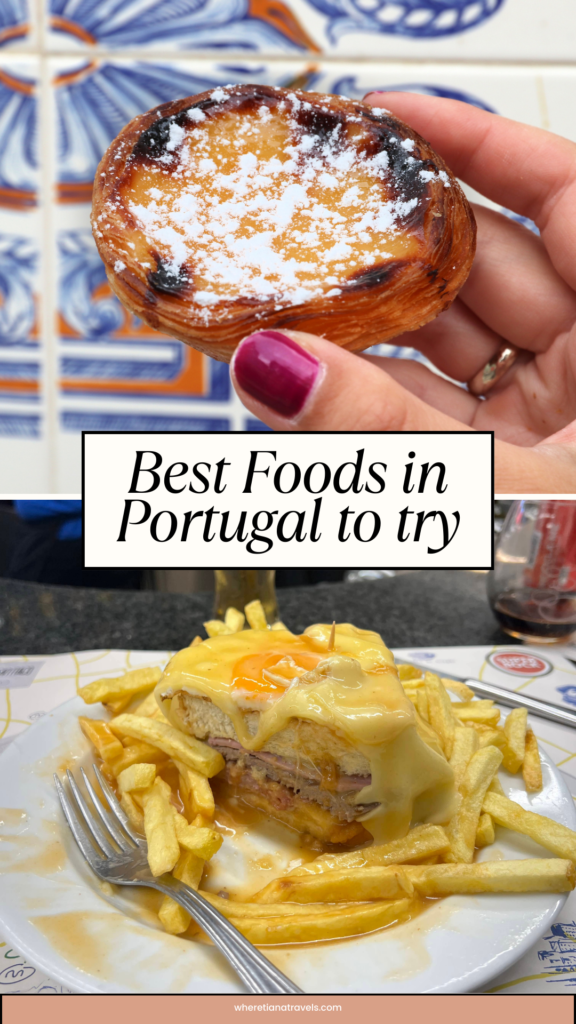

If you think Portuguese cuisine is all about salted cod and custard tarts, then brace yourselves. There’s a whole world of lip-smacking, drool-worthy, and Instagrammable deliciousness waiting for you in the land of sun, sea, and Port wine.
And what better way to dive into the culinary scene than exploring the best food that Portugal has to offer?
From the iconic Bacalhau to the humble yet heavenly Pastel de Nata, Portuguese food is a medley of robust flavors and heartwarming comfort. With the Atlantic Ocean serving as a generous pantry of fresh seafood, and a tradition of hearty, rustic fare, the local cuisine is anything but bland.
Related read: 40 Fun & Unique Things to Do in Lisbon
In this post, you'll find...
History and Influence on Portuguese Cuisine
But before we get to the nitty-gritty, let’s talk a bit about why Portuguese food tastes the way it does.
Portugal owes a lot to their rich history and the myriad of cultures that have influenced them over the centuries. Their seafaring explorers, bless their hungry souls, set sail to discover new lands, but they also brought back a slew of spices, techniques, and ingredients that changed our culinary landscape forever.
From the heat of chili peppers to the exoticism of vanilla, Portuguese forebears had a knack for infusing their cooking with some serious pizzazz. Add to that a wine culture that’s as old as the hills (here’s looking at you, Vinho Verde) and a love for fresh, simple ingredients, and you have a cuisine that’s diverse, dynamic, and downright delectable.
Related read: When’s the Best Time to Visit Portugal?
Regional Dishes and Specialties
Portugal may be small, but when it comes to food, they’re big on flavor and regional variety. Each corner of their sun-kissed land boasts its own culinary treasures.




From Caldo Verde in the verdant north to the suckling pig of the central regions and the Piri-Piri Chicken of the southern Algarve, these regional dishes reflect the landscapes, histories, and cultures of their areas.
Take Cozido à Portuguesa, for instance. It’s a delicious boiled mix of meats and vegetables, a bit like a Portuguese version of roast beef and potatoes, that’s originally from Northern Portugal. But it’s loved nationwide for good reason: it’s comfort food at its best.
Or consider the Açorda of the Alentejo region. It’s a humble dish made of leftover bread soaked in a garlic and coriander broth, crowned with a poached egg. This dish isn’t just delicious; it’s a testament to the Portuguese ability to turn simple ingredients into soul-satisfying meals.
Essential Portuguese Dishes to Try in Portugal
Now, let’s get to the real meat of the matter, or in the case of Bacalhau à Brás, the real fish of the matter.
Here are some of the best Portuguese dishes that will make you want to book the next flight out to Portugal.
1. Bacalhau (Salted Cod)
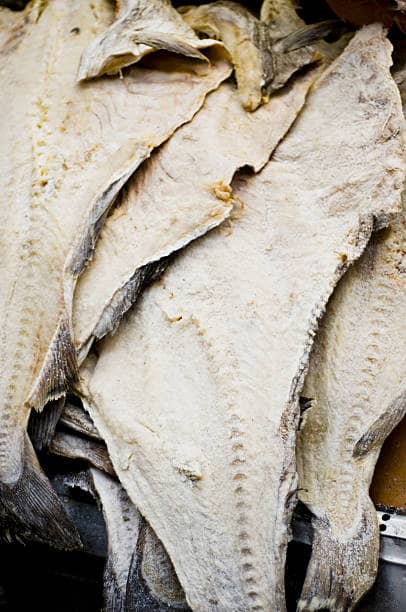



If there’s one dish that personifies Portuguese cuisine, it’s Bacalhau. Funny thing is, they don’t even fish for cod in Portugal. But, centuries ago, Portuguese explorers found the perfect cod in the icy Atlantic waters off Newfoundland. It was salted and dried to last the long journey home, and the rest is culinary history. The Portuguese love Bacalhau so much that there are said to be over 365 ways to cook it, one for each day of the year! From Bacalhau à Brás (shredded cod with onions, eggs, and fries) to Bolinhos de Bacalhau (cod fritters), this fish is a national treasure.
Where to try it: Head north for the best Bacalhau à Gomes de Sá, a hearty combo of cod, potatoes, and onions.
2. Pastel de Nata (Custard Tart)
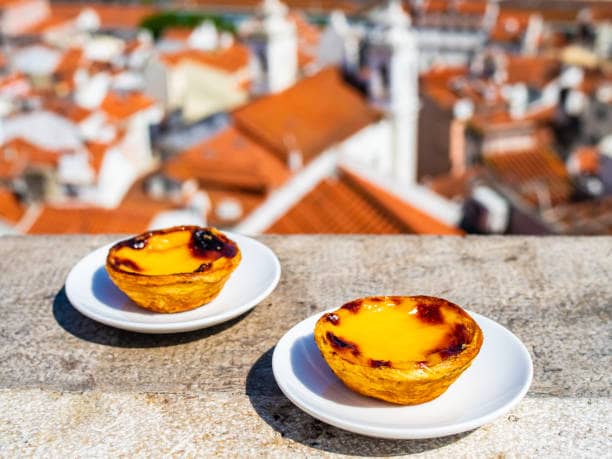



These little pastry shells filled with creamy custard and dusted with cinnamon are the undisputed stars of Portuguese desserts. Believed to have been created by monks at the Jerónimos Monastery in Belém, the original recipe is a closely guarded secret. Yet, this hasn’t stopped pastry shops around the country from making their own versions. These tarts are the perfect balance of flaky crust and creamy filling, best enjoyed slightly warm.
Where to try it: For the real deal, head to the Antiga Confeitaria de Belém, home of the original Pastéis de Belém.
3. Polvo à Lagareiro (Octopus with Olive Oil and Potatoes)
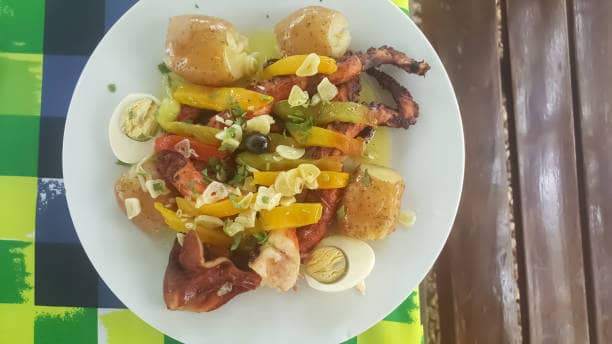



Seafood lovers, rejoice! Here’s a dish that showcases the Atlantic’s bounty in all its glory. Octopus is tenderized, roasted, and served with punched potatoes drenched in a generous glug of olive oil and garlic. The best Polvo à Lagareiro? It’s waiting for you in the coastal towns, where the octopus is as fresh as it gets.
Where to try it: Try it in Setúbal, south of Lisbon, and wash it down with a chilled white wine.
Related read: Where to stay in Lisbon: Best Neighborhoods & Hotels
4. Porco Preto (Iberian Black Pork)
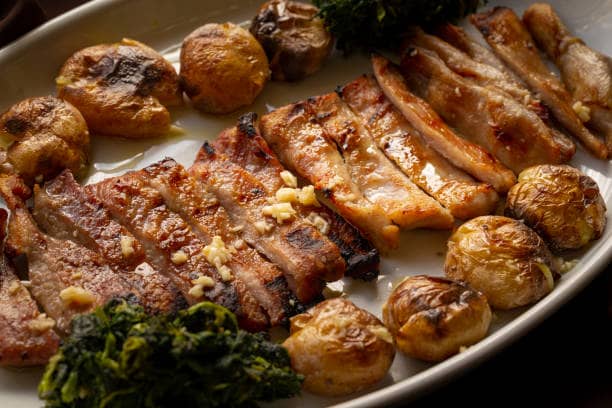



Hailing from the vast, cork-oak dotted landscapes of Alentejo, Porco Preto (Iberian Black Pork) is the epitome of exceptional Portuguese fare. Rooting around for acorns under the cork trees, these black pigs lead a life that’s as organic as it gets, and this lifestyle imparts the meat with a nutty, delectably unique flavor that sets it apart. The traditional preparation is refreshingly straightforward, with the pork usually simply grilled and occasionally adorned with a squeeze of tangy lemon juice. This method puts the succulent, flavorsome meat in the spotlight where it truly belongs.
Where to try it: To enjoy the best Porco Preto, you should visit any of the rustic taverns in Alentejo’s capital, Évora. Here, pair your meal with a local Alentejo red wine, and you’ve got yourself a culinary match made in heaven.
5. Arroz de Pato (Duck Rice)
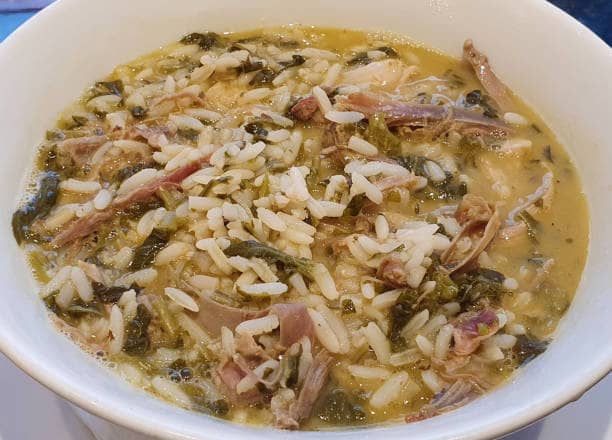



Few dishes encapsulate the rustic comfort of Portuguese cuisine like Arroz de Pato. This oven-baked fusion of rice, duck, and often slices of spicy Spanish chorizo results in a meal that warms the soul as much as it pleases the palate. The dish hails from the ancient city of Braga, nestled in the green Minho province in Northern Portugal. The secret to its irresistibility lies in the contrast of textures — the duck’s tender meat against the slightly crisp top layer of rice that’s achieved through oven baking. A trip to the north wouldn’t be complete without tucking into a plate of Arroz de Pato.
Where to try it: Make your way to the old town of Braga, where traditional restaurants serve this beloved dish following age-old recipes. Accompanied by a glass of the region’s Vinho Verde, this is Portuguese comfort food at its absolute best.
6. Sardinhas Assadas (Grilled Sardines)
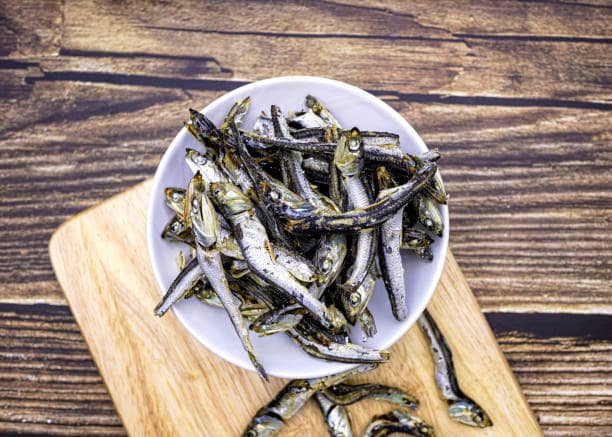



For a classic taste of Portugal’s seafood prowess, look no further than Sardinhas Assadas, or grilled sardines. Quintessentially Portuguese, these silver delights from the Atlantic are at their prime during the summer months. Grilled to perfection over hot coals, the sardines attain a slightly crispy exterior while remaining succulent inside. With a splash of lemon juice, they embody simplicity and freshness.
Where to try it: Lisbon, during the Festas de Lisboa in June, is undoubtedly the best place to savor these. Street stalls across the city grill them by the dozen, their smoky aroma filling the air, making them impossible to resist.
7. Francesinha (“Little Frenchie”)




Originating from the vibrant city of Porto, Francesinha is a meat-lover’s dream come true. This is not a sandwich for the faint-hearted! A sumptuous stack of bread, wet-cured ham, linguiça, fresh sausage, steak, covered with molten cheese and doused in a rich, hot tomato and beer sauce then topped with a fried egg, it’s a culinary adventure. Often served with a side of French fries, this is comfort food at its finest.
Where to try it: To enjoy the original Francesinha, head to its birthplace, Porto, where cafés and taverns across the city serve their own versions of this hearty treat. I tried my first Francesinha at Café Santiago in Porto, at the recommendation of my hotel receptionist – and it was amazing.
8. Arroz de Marisco (Seafood Rice)
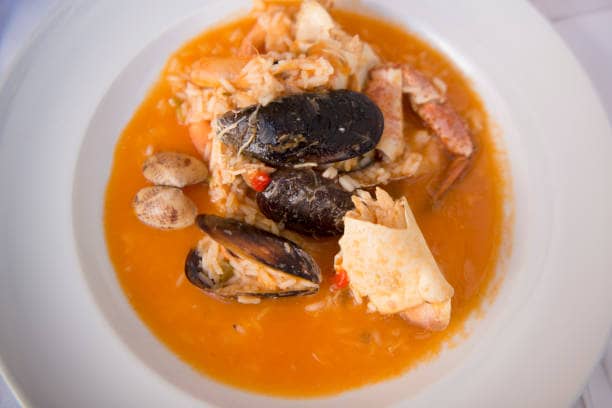



Arroz de Marisco is a testament to Portugal’s bountiful coastline, featuring an assortment of shellfish like crab, shrimp, clams, and lobster, all nestled in a bed of aromatic saffron rice. This dish, similar to Spain’s paella but soupier, is a celebration of the ocean’s bounty. It originates from the fishing village of Vieira de Leiria, where fresh seafood is in abundance. The combination of various seafood with the subtly flavored rice results in a rich and comforting dish that’s hard to forget.
Where to try it: Head to any of Portugal’s coastal towns for this tasty seafood dish.
9. Açorda (Bread Soaked in Broth)
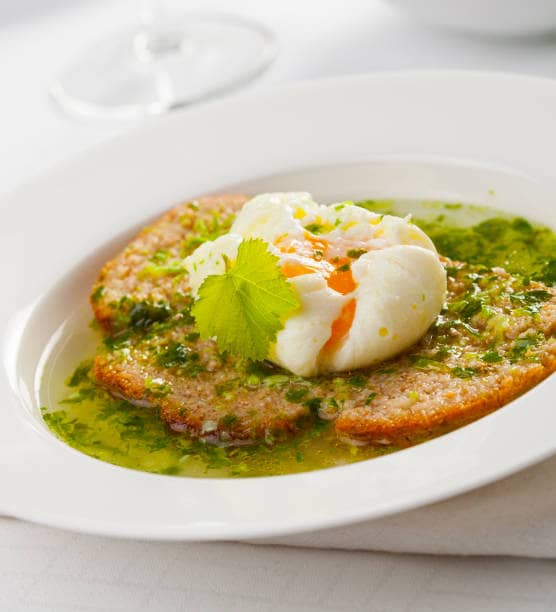



Bread, the humble staple, takes center stage in Açorda. This savory, garlicky dish showcases the Alentejo’s resourcefulness and ability to create flavor-packed dishes from simple ingredients. Day-old bread is soaked in a rich broth made with garlic, coriander, olive oil, and poached eggs. Although it varies by region, the Alentejo style Açorda is particularly loved.
Where to try it: You should venture to Portugal’s serene countryside for an authentic taste, where this warming, rustic dish is lovingly prepared in traditional taverns.
10. Queijo (Cheese)
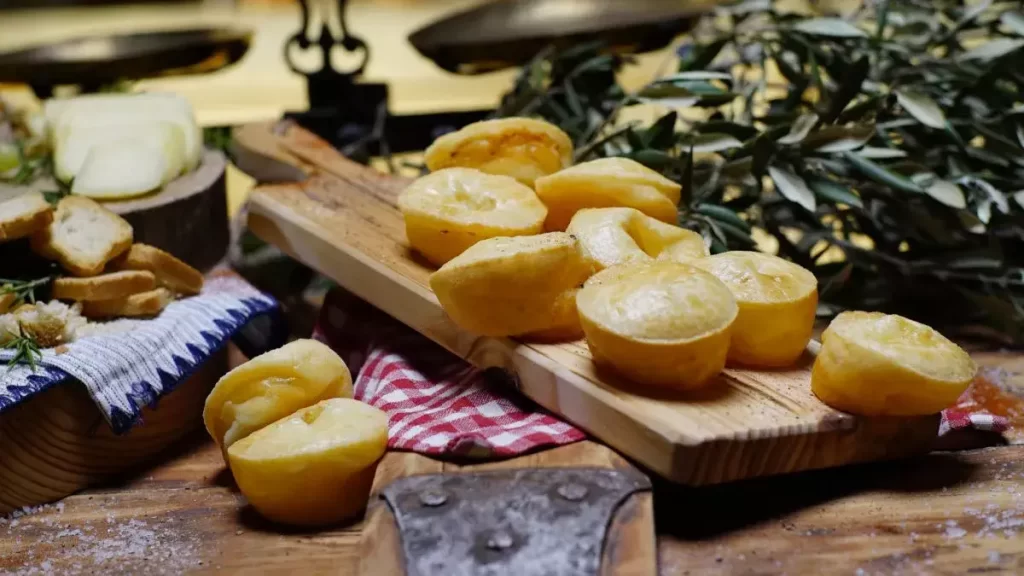



Cheese enthusiasts are in for a treat when exploring the rich dairy landscape of Portugal. With countless varieties produced across the country, Portuguese cheese is a universe of diverse flavors and textures. One that truly stands out is Queijo Serra da Estrela, made in the mountainous Serra da Estrela region. This is Portugal’s oldest and most revered cheese, with a creamy, slightly tangy interior that’s perfect for spreading on bread.
Where to try it: For the best experience, visit the quaint town of Celorico da Beira, known as the ‘capital of Serra da Estrela cheese.’
11. Prego (Steak Sandwich)
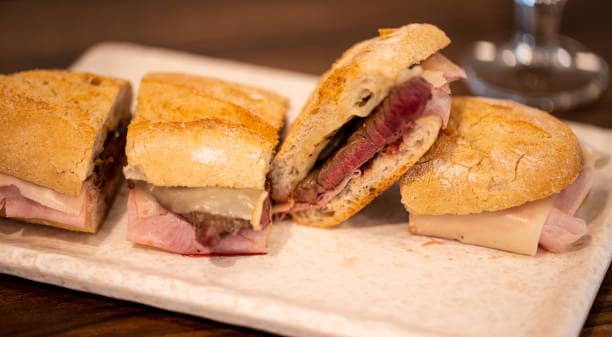



Quick, simple, and intensely satisfying, the Prego is Portugal’s answer to the steak sandwich. A juicy beef steak, seasoned with garlic and sometimes mustard, nestled in a crispy bread roll – it’s uncomplicated yet undeniably delicious. Typically eaten as a main meal or even a dessert after seafood in Lisbon’s cervejarias (beer houses), it’s a versatile delight.
Where to try it: Visit Beira Gare, a bustling eatery in the heart of Lisbon, known for its outstanding Pregos.
12. Cataplana de Marisco (Seafood Stew)
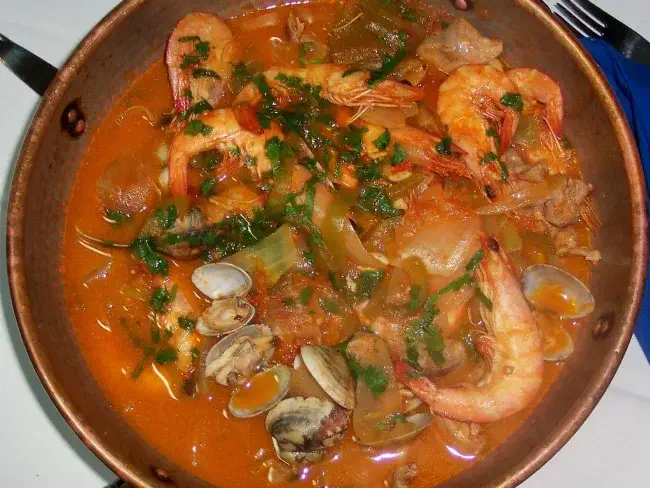



Named after the clam-shaped copper pan it’s cooked in, Cataplana de Marisco showcases the best of Portuguese seafood in a one-pot wonder. Mussels, clams, prawns, and chorizo are simmered with white wine, tomatoes, and spices to create a flavorful stew that pairs perfectly with crusty bread. The Algarve region, known for its fresh seafood and unique Moorish influence, offers the best Cataplana experience.
Where to try it: Don’t miss the beachside restaurants in Faro, where you can indulge in this savory delight with a stunning ocean view.
13. Lapas (Limpets)
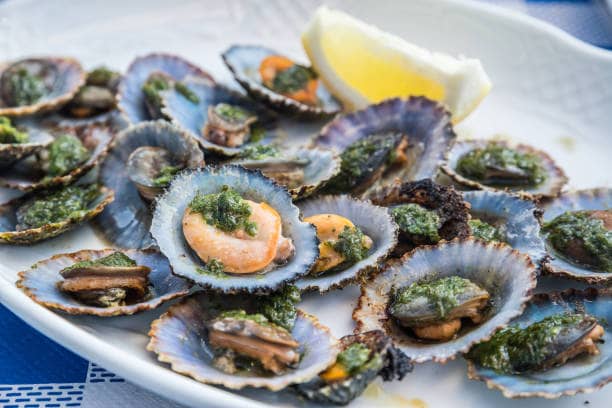



Lapas, or limpets, are small sea creatures that cling to the rocky shores of the Azores and Madeira islands. Grilled with a bit of garlic and lemon juice, they offer an authentic taste of the Atlantic Ocean. Although seemingly humble, lapas are a delicacy and a staple of the local diet on these islands.
Where to try it: For the best and freshest lapas, head to the stunning volcanic island of Pico in the Azores, where sea-to-table takes on a whole new meaning.
14. Bifanas (Portuguese Sandwiches)
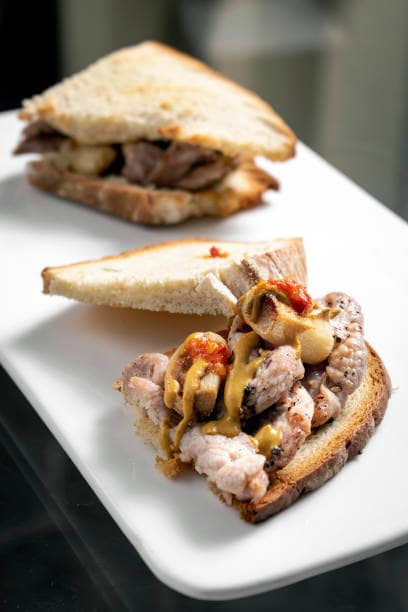



Portugal has an undying love for sandwiches, and Bifanas are the nation’s beloved. Imagine a crusty Portuguese roll cradling thin slices of marinated pork that have been flash-fried and drenched in a garlic and white wine sauce. This is not just a sandwich, it’s a cultural institution!
Where to try it: Vendas Novas, a small town in Alentejo, claims to be the birthplace of the Bifana and even hosts an annual festival celebrating it. Visit the local food markets there for the most authentic Bifanas.
15. Alheira (Portuguese Sausage)
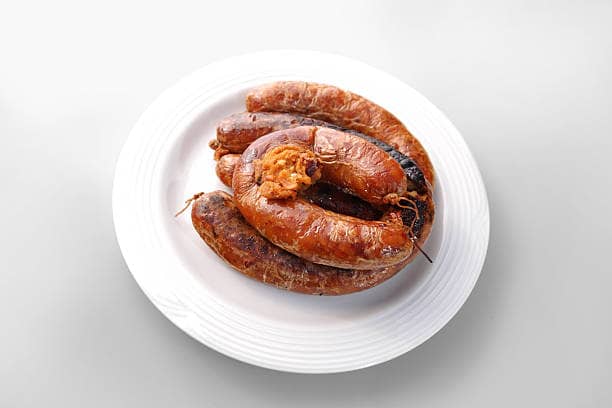



The Alheira sausage has a fascinating history. It was invented by Portuguese Jews during the Inquisition as a decoy to conceal their faith, since Jews didn’t eat pork. These days, Alheira can contain a variety of meats, including poultry, game or even fish, mixed with bread for texture.
Where to try it: The town of Mirandela in the North is renowned for its Alheiras, so much so that they have a designation of protected origin. Make sure to try an “Alheira de Mirandela” when you visit the area.
16. Piri-Piri Chicken
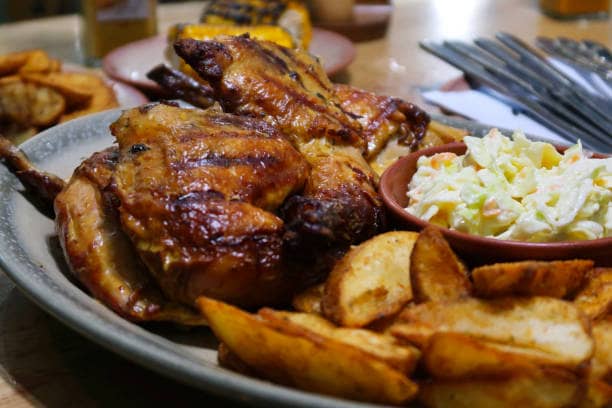



This fiery dish is a testament to Portugal’s adventurous spirit. The piri-piri pepper was introduced by Portuguese explorers returning from Africa, and it quickly found its way into local cuisine. The spicy, tangy Piri-Piri Chicken, or Frango à Piri-Piri, is a Portuguese BBQ staple.
Where to try it: For the best experience, head to Guia, a small town in the Algarve region, known as the “Capital of Chicken” where the locals claim the original recipe was born.
17. Caldo Verde (Traditional Portuguese Soup)
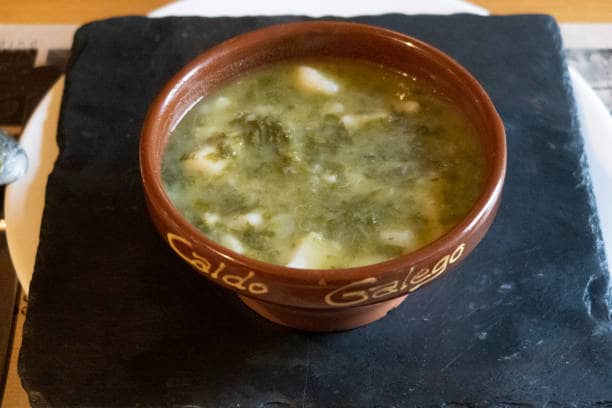



Caldo Verde, literally “green broth,” is one of Portugal’s most popular soups. Originating from the Minho province in the north, this comforting soup is a blend of thinly sliced kale, potatoes, olive oil, and often chorizo. Best enjoyed with a slice of hearty broa de milho (Portuguese cornbread), it’s a favorite for late-night suppers and festive occasions.
Where to try it: Be sure to try this beloved soup in any of the cozy taverns in Porto, where it’s served hot and fresh, promising to soothe your soul with each spoonful.
The Culture of Dining in Portugal
Portugal’s cuisine is a vibrant tapestry woven by its history, geography, and the Portuguese people’s love for good food. Much like its landscape, the dining culture varies from the mountains in the north to the sun-kissed southern coast, yet certain universal themes prevail.
Now, if you’re wondering what the best way to enjoy Portuguese food is, remember, it’s all about the 3 S’s: Slow, Social, and Savor.
Portuguese love their meals long, tables full, and conversations lively.
Mealtime in Portugal is more than just a routine—it’s a ritual that’s rich in tradition and filled with enjoyment. It’s a time to relax, share, and engage in lively conversation. Portuguese meals often last several hours, with multiple courses interspersed with local wine and convivial chatter.
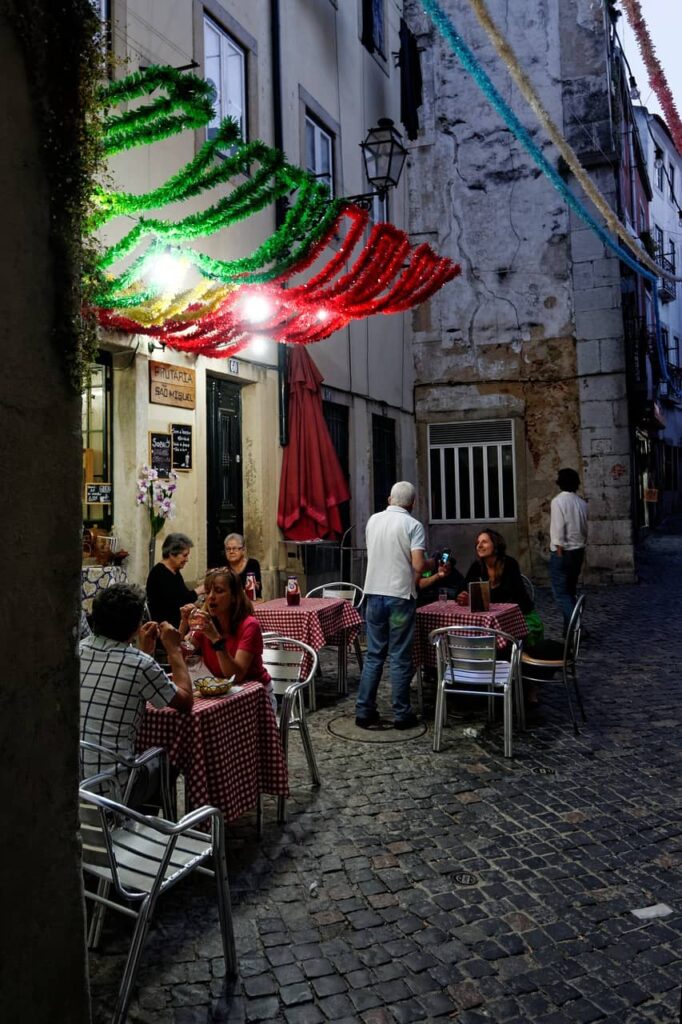



Contrasting with many cultures that reserve wine for special occasions, in Portugal, a glass of Vinho Verde or a bold red from the Douro region often accompanies even weekday meals.
Notably, the cozido à portuguesa, a meat and vegetable stew, is a favorite for Sunday lunch, gathering families around the table in celebration of the week’s end.
In restaurants, the concept of “rush” seems alien. Guests are encouraged to savor their meals, and the check is only brought when requested, further extending the leisurely pace of Portuguese dining.
Portuguese desserts, especially pastéis de nata, are beloved and are an integral part of the coffee culture. Pastry shops and cafés abound, making it easy to indulge in these sweet treats throughout the day.
Practical Tips for Food Lovers Traveling to Portugal
For food lovers, Portugal is a year-round destination with culinary delights at every turn. However, timing your visit with local food festivals can provide a unique insight into the food culture. The National Gastronomy Festival in Santarém in October is a must-visit, offering a smorgasbord of traditional dishes from across the country.
When dining out, be adventurous! Don’t hesitate to ask the locals for recommendations—they are usually more than happy to share their favorite spots and dishes. A pastel de nata at the Antiga Confeitaria de Belém or a helping of Polvo à Lagareiro at Ramiro in Lisbon comes with the satisfaction of trying an original recipe in its home setting.
For authentic local food experiences, explore the tascas—small, often family-owned restaurants that serve hearty traditional dishes. These are the best places to try staples like Caldeirada de Peixe, a fish stew, or Alheira de Mirandela, a Portuguese sausage.
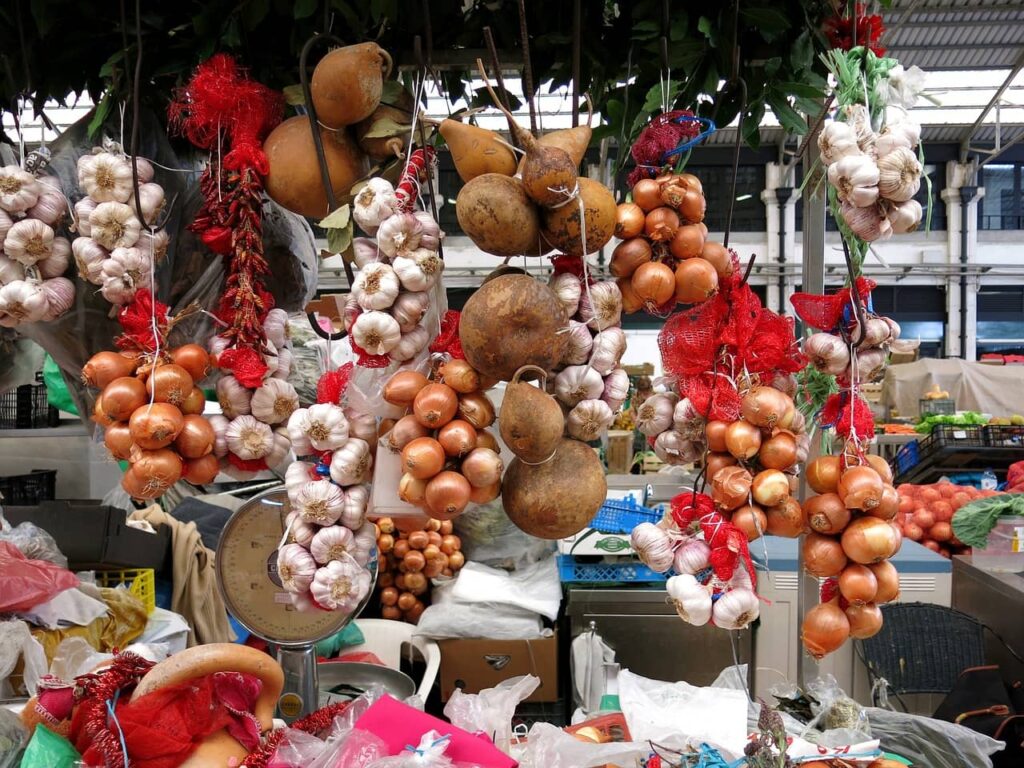



Do learn some Portuguese food vocabulary. Knowing the difference between a Prego (steak sandwich) and Bifanas (pork sandwiches), or distinguishing Bolinhos de Bacalhau (cod fritters) from Pasteis de Bacalhau (another type of cod cake), will come in handy.
Finally, enjoy the journey! From the seafood of the Atlantic to the suckling pig of Bairrada and the unique cheeses of the Serra da Estrela, Portugal’s culinary landscape is as diverse as it is delicious. Take your time, eat like a local, and your Portuguese food adventure will undoubtedly be a journey to remember.
Hi, I’m Tiana – founder of and author here at Where Tiana Travels. I’m a 20-something with a love for all things travel, photography, and food. I have been living abroad for the past 5 years and solo traveling the globe in my free time. I created this blog to share my travel stories and inspire other women to go out and see the world. Read more about me here!

